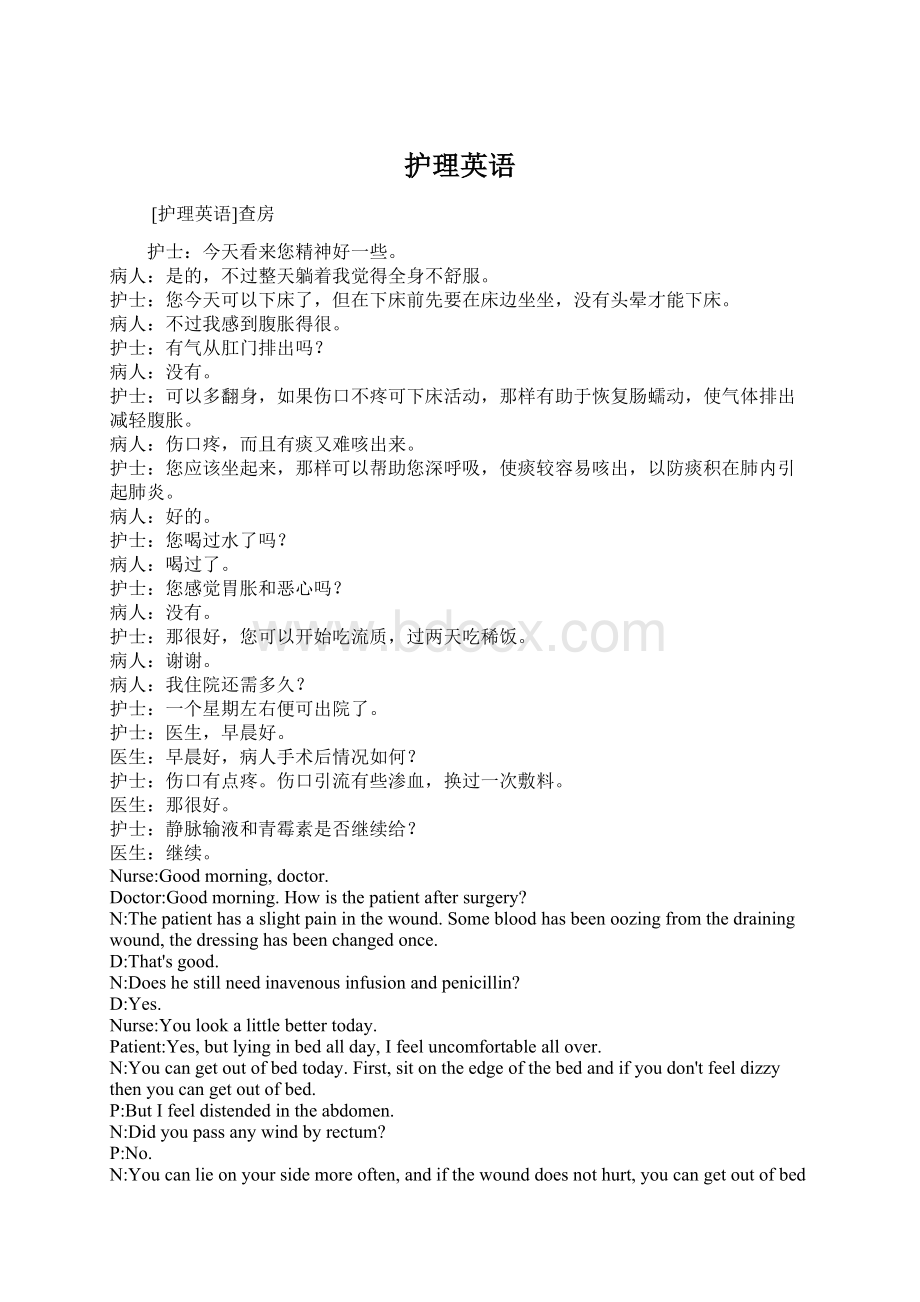护理英语.docx
《护理英语.docx》由会员分享,可在线阅读,更多相关《护理英语.docx(55页珍藏版)》请在冰豆网上搜索。

护理英语
[护理英语]查房
护士:
今天看来您精神好一些。
病人:
是的,不过整天躺着我觉得全身不舒服。
护士:
您今天可以下床了,但在下床前先要在床边坐坐,没有头晕才能下床。
病人:
不过我感到腹胀得很。
护士:
有气从肛门排出吗?
病人:
没有。
护士:
可以多翻身,如果伤口不疼可下床活动,那样有助于恢复肠蠕动,使气体排出减轻腹胀。
病人:
伤口疼,而且有痰又难咳出来。
护士:
您应该坐起来,那样可以帮助您深呼吸,使痰较容易咳出,以防痰积在肺内引起肺炎。
病人:
好的。
护士:
您喝过水了吗?
病人:
喝过了。
护士:
您感觉胃胀和恶心吗?
病人:
没有。
护士:
那很好,您可以开始吃流质,过两天吃稀饭。
病人:
谢谢。
病人:
我住院还需多久?
护士:
一个星期左右便可出院了。
护士:
医生,早晨好。
医生:
早晨好,病人手术后情况如何?
护士:
伤口有点疼。
伤口引流有些渗血,换过一次敷料。
医生:
那很好。
护士:
静脉输液和青霉素是否继续给?
医生:
继续。
Nurse:
Goodmorning,doctor.
Doctor:
Goodmorning.Howisthepatientaftersurgery?
N:
Thepatienthasaslightpaininthewound.Somebloodhasbeenoozingfromthedrainingwound,thedressinghasbeenchangedonce.
D:
That'sgood.
N:
Doeshestillneedinavenousinfusionandpenicillin?
D:
Yes.
Nurse:
Youlookalittlebettertoday.
Patient:
Yes,butlyinginbedallday,Ifeeluncomfortableallover.
N:
Youcangetoutofbedtoday.First,sitontheedgeofthebedandifyoudon'tfeeldizzythenyoucangetoutofbed.
P:
ButIfeeldistendedintheabdomen.
N:
Didyoupassanywindbyrectum?
P:
No.
N:
Youcanlieonyoursidemoreoften,andifthewounddoesnothurt,youcangetoutofbedandwalkaround,thatwillhelpperistalsisoftheintestinewhichwillhelptopassgasandlessensdistension.
P:
Thewoundispainfulandthesputumisdifficulttoexpectorate.
N:
Youshouldsitup.Thatwillhelpyourdeepbreathing,andhelpyoutoexpectorateandpreventthesputumfromaccumulatinginyourlungstocausepneumonia.
P:
Allright.
N:
Didyoudrinkanywater?
P:
Yes.
N:
Doyoufeeldistendedandnausea?
P:
No.
N:
That'sgood.Youcanstartonafluiddietandcongeeintwodays.
P:
Thankyou.
P:
HowlongmustIstayinhospital?
N:
Youcangohomeinaboutaweek.
[护理英语]测量体温
学生:
测体温应该使用什么样的体温计?
护士:
常用有水银柱的摄氏或华氏体温计测量。
学生:
测量体温的作用什么?
护士:
体温和其他生命体征(如:
呼吸、脉搏和血压)共风吹草动反应出病人的情况。
学生:
试口表时有什么禁忌吗?
护士:
给4-5岁以下的孩子测体温不能使用口表(避免口腔粘膜的损伤,一旦张口造成的不准确,以及咬破体温计的危险。
学生:
还有哪些病人不能使用口表。
护士:
由于面部伤残或鼻腔的阻塞,如外伤或鼻腔内有插管,病人不能张口,闭口的不能使用。
口腔有感染和昏迷的病人也不能使用口表。
student:
Whatkindofthermometerwouldbeusedtakingabodytemperature?
Nurse:
Aglass-enclosedtubeofmercurycallibratedonacelsiusorFahrenheitscaleisused.
S:
Whatisthefunctionoftakingthebody'stemperature?
N:
Bodytemperatureisusedinconjunctionwiththeothervitalsigns(respiration,pulseandbloodpressure)toassessthepatient'spresentcondition.
S:
Whatiscontraindicationwhiletakingthetemperatureorally?
N:
Oraltemperaturewithclinicalthermometershouldnotbetakenbychildrenbelow4-5yearsofage(dangerofinjurytomucosa,inaccurateifmouthopenanddangerofbitingthermometer).
S:
Whatotherkindsofpatientscannotuseoralthermometer?
N:
Thepatientswhocannotopenorclosetheirmouthbecauseoffacialhandicapsorinjuriesornasalobstructionduetotubesorinjuries.
Thepatientswithmouthinfectionsandunconsciouscannotuseoralthermometer.
[护理英语]异常体温
护士:
发烧或发热指体温高于正常标准。
其原因可能是体温调节中枢功能紊乱、热源刺刺激,气温过高或体温逸散功能受损。
学生:
有几种热型?
护士:
有三种。
即:
间歇热、弛张热和回归热。
学生:
请您解释一下"体温过低"是什么意思?
护士:
"体温过低"是指低于正常低温。
nurse:
Fever,orpyrexia,isanelevationofthebodytemperatureabovenormalItmaybecausedbymalfunctonofthetemperatureregulatingcenter,theresponseofthecentertoapyrogen,exposuretoaveryhighenvironmentaltemperature,orimpaireddissipation.
Student:
Howmanytypesoffeverarethere?
N:
Therearethreetypes,intermittentfever,remittentfeverandrelapsingfever.
S:
Willyoupleaseexplainthetermhypothermia?
N:
Hypothermiameansasubnomalbodytemperature.
[护理英语]体温监护
护士:
准确地监护体温是一项重要的护理措施,体温反映人体热量并可以提供病人的信息。
学生:
人体的正常体温多少?
护士:
人体的正常体温约为37℃。
直肠温度大约是36.5-37.5℃。
口腔温度比直肠温度低0.3-0.5℃。
腑下温度比口腔温度又低0.2-0.4℃。
学生:
那么,哪一个温度最准呢?
护士:
直肠温度最准。
因为它是在体腔内,接近血液温度。
学生:
一天给病人试几次体温。
护士:
有些病人一天试两次体温。
而另外一些病人4个小时甚至两小时试一次体温。
学生:
什么时间为病人试表?
护士:
通常试体温的时间是在上午八点,下午4点。
发烧病人应4个小时或两个小时试一次体温。
学生:
我们测量体温时,是否还要测量脉搏和呼吸?
护士:
是的。
护士不仅测量体温,还要数脉搏和呼吸。
护士:
你知道测量口表时应注意什么吗?
学生:
是的,我知道。
测口温时要告诉病人闭紧口腔,但要小心不能把体温计咬断。
如果将玻璃或水银吞下,那是很危险的。
学生:
如果病人吞服了水银该怎样处理呢?
护士:
应该让病人立即喝一些蛋白水或牛奶。
nurse:
Monitoringbodytemperatureaccuratelyisanimportantnursingmeasure.Bodytemperaturereflectstheheatcontentofthebodyandmayprovideinformationofthepatient.
Student:
Whatisthenormaltemperatureofthehumanbody?
N:
Thenormaltemperatureofthehumanbodyisabout37℃.Therectaltemperatureisabout36.5℃--37.5℃.Themouthtemperatureis0.3-0.5℃lowerthantherectaltemperature.Theaxillarytemperatureis0.2-0.4℃lowerthanthemouth.
S:
Thenwhichisstandard?
N:
Therectaltemperatureisstandard,becauseitisinthecavityofthebodyandnearlythetemperatureoftheblood.
S:
Howmanytimesadaydowetaketemperatureforthepatient?
N:
Somepatientsaretakentemperaturetwiceadayandotherseveryfourhoursoreveneverytwohours.
S:
Whendowetakethetemperatureforthepatients?
N:
Usuallywetakeitat8a.m.And4p.M..Thefeverishpatientsshouldbetakentheirtemperatureeveryfourhoursoreverytwohoursdaily.
S:
Souldpulseandrespirationbetakenwhilethetemperatureisbeingtaken?
N:
Yes,thenursenotonlytakesthetemperaturebutalsocountsthepulseandrespiration.
N:
Doyouknowwhataretheprecautionswhiletakingone'stemperatureorally?
S:
Yes.Weshouldtellthepatientstoclosetheirmouthsandbecarefulnottobreakthethermometerandswallowtheglassormercury.Itwouldbeverydangerous.
S:
Howdoyoutreatthatifthepatientsswallowthemercury?
N:
Thepatientwouldtakesomeeggwhiteormilkimmediately.
[护理英语]输血
学生:
人类的血型有几种?
老师:
人类有重要临床意义的4种主要血型是A,B,AB和O型。
学生:
医院里有血液供给病人吗?
老师:
每个医院都有大量血液以供输注。
学生:
存在哪里呢?
老师:
血液存在医院的血库内。
学生:
血液是从哪里来的?
老师:
血献血员供给。
学生:
对献血员有什么要求吗?
老师:
要求其年龄在18-65岁之间,身体一身健康,可以通过必需的体格检查。
学生:
为什么要给献血员做体格检查。
老师:
在输血前,要给献血员做检查,以便确定其血型和没有任何疾病。
这些完成之后,才可以在献血员身上抽血。
学生:
一个人有什么病不能献血?
老师:
疟疾、贫血、传染性肝炎、结核……等。
学生:
输血前什么准备工作?
老师:
我们先给病人验血型,然后,病人的血和献血员的血做交叉凝集试验,凡是无凝集的才能使用。
学生:
输血需要什么设备?
老师:
输血设备有:
①输血管带有两上囊,上囊为过滤器,下囊为点滴速率器。
②18-20号针头。
③消毒棉签。
④止血带。
⑤橡皮膏。
学生:
病人在输血过程中我们应该注意什么?
老师:
①病人用的所有器械都必须进行灭菌处理。
②认真核对血型。
③输血前先输少量的生理盐水。
④输血时我们要注意病人的反应。
学生:
输血时每分钟滴速是多少?
老师:
一般滴速每分钟40到60滴。
学生:
病人在输血过程中为什么出现手足抽搐现象?
老师:
输血的同时,输入了枸缘酸钠,而枸缘酸钠在体内与游离钙结合,因而血钙下降,故出现四肢抽搐。
学生:
输血会有哪些反应?
老师:
过敏反应、循环衰竭、空气栓塞、传染性疾性,如疟疾、传染性肝炎。
学生:
什么反应较为严重?
老师:
溶血反应。
学生:
什么药物可以预防输血反应?
老师:
苯海拉明、盐酸异丙嗪和氟美松。
student:
Howmanytypesofbloodarethereinthenumanbeing?
Teacher:
ThefourmajorbloodtypesofclinicalimportanceinthisgeneticsystemareA,B,ABandO.
S:
Arethereanybloodforthepatientinthehospital?
T:
Everyhospitalhasalotofbloodforthetransfusion.
S:
Whereisitpreserved?
T:
Thebloodispreservedinthebloodbankofthehospital.
S:
Whereisthebloodfrom?
T:
Itisgivenbythedonor.
S:
Whatistherequirementtothedonor?
T:
Aperson18to65yearsoldwithanegativemedicalhistory,capableofpassingtherequiredphysicalexamination.
S:
Whyisthedonorgivenphysicalexamination?
T:
Beforegivingblood,thedonorisgiventeststodeterminehisbloodgroupandmakesureheisnotsufferingfromcertaindisease.Whenthishasbeendonehisbloodcanbetaken.
S:
Apersonwithwhatdiseasecannotbetakentheblood?
T:
Malaria,anemia,infectioushepatitis,tuberculosisandsoon.
S:
Whatisthepreparationbeforebloodtransfusion?
T:
First,wegetbloodgroupofpatient.Andthenthepatient'sanddonor'sbloodmakecrossmatching.Ifitisnegativeitcanbeused.
S:
Whataretheequipmentsfortransfusion?
T:
Theequipmentsfortransfusionare:
①Tubingwithattachedtwochambers;anupperfilterchamberandalowerdrip-ratechamber.②Needle18to20gauge.③Antisepticpledget.④tourniquet.⑤adhesiveplaster.
S:
Whatattentionshouldwepaytobloodtransfusionforthepatient?
T:
①Alltheinstrumentsthatcomeintocontactwiththepatientmustbesterilised.
②Checkupbloodgroupearnestly.③Transfusealittlenormalsalinebeforebloodtransfusion.④Duringthebloodtransfusion,weshouldpayattentiontoreactionofpatient.
S:
Howmanydripsaminuteinthebloodtransfusion.
T:
Theusualrateofinfusionisfrom40to60dropsperminute.
S:
Whydothearmsandlegstwitchduringthebloodtransfusion?
T:
Somecitratehavebeentransfusedintothebodyduringthebloodtransfusion.Thesodiumcitratecombineswithfreecalcimintothebody.Sobloodcalcimdescendandthetwitchofarmsandlegsappear.
S:
Whatarethereactionsinthebloodtransfusion?
T:
Allergicreactions,circulatoryoverload,airembolism,infectiousdiseases,suchasmalariaandinfectivehepatitis.
S:
Whatreactionissevereduringthebloodtransfusion?
T:
Hemolysisreaction.
S:
Whatmedicinemaybeusedtopreventthereactionofbloodtransfusion?
T:
Benadzy1,PromethazineandDexamethasoul.
[护理英语]吸氧治疗
老师:
吸氧治疗在18世纪就开始应用了。
今天差不多用于所有形式的急性呼吸衰竭。
学生:
有多少种设备可用来为病人输氧?
老师:
为自动呼吸的病人输送氧气的设备有三组:
①氧罩。
②鼻管。
③氧气帐及氧气盒。
学生:
湿化很重要吗?
老师:
是的,最常用的是湿化瓶,它只是在室温下把干燥的氧气在水瓶中滤过。
techer:
Oxygentherapyhasbeenusedinpatientcareinthe18thcenturyandtodayitisusedinalmostallformsofacuterespiratoryfailure.
Student:
Howmanylindsofequipmentareusedtodeliveroxygentopatient?
T:
Therearethreefunctionalgroupswhicharedesignedtodeliveroxygentothespontaneouslybreathingpatient:
①Facemasks.②Nasalcannulae.③Tentsandboxes.
S:
Ishumidificationveryimportant?
T:
Yes,themostwellknownexampleisthewoulfebottle.Itworkssimplybybubblingthedrygasthroughwateratroomtemperature.
[护理英语]输氧
护士:
让我给您多垫一个枕头,您得吸点儿氧。
病人:
我要做什么呢?
护士:
我给您下鼻管,再把软管粘在您的脸上。
病人:
哎呀,我的鼻眼可真是碰不得。
护士:
不用担心,我给您试试氧气罩。
不过,我想您还是不用氧气室,对不对?
病人:
那当然,如果那样,我就没救了。
n:
Letmeputanotherpillowunderyourhead.Youhavetobreathesomeoxygen.
P:
WhatshallIdothen?
N:
No,I'llputnasalcannulaeintoyournostrilsandtapethetubesontoyourcheek.
P:
Well,mynostrilsareverysensitive.
N:
Don'tworry.I'lltrythemask.AndIdon